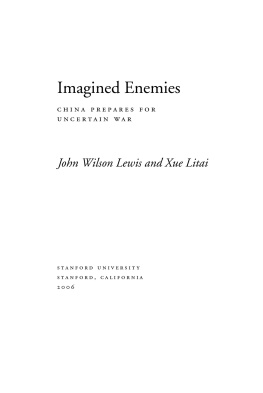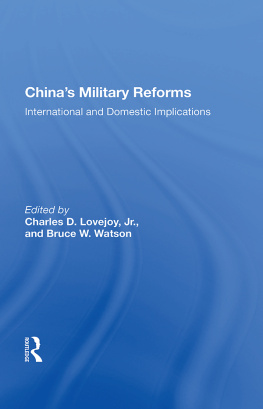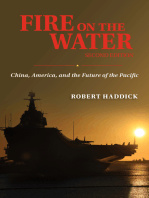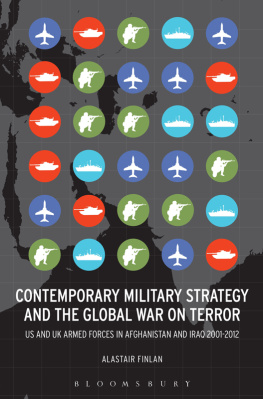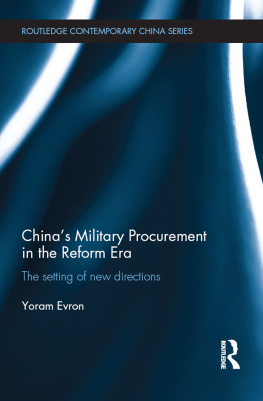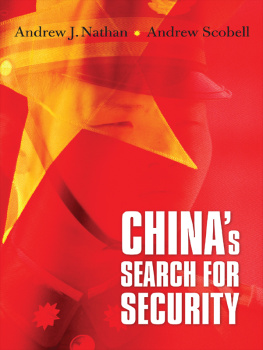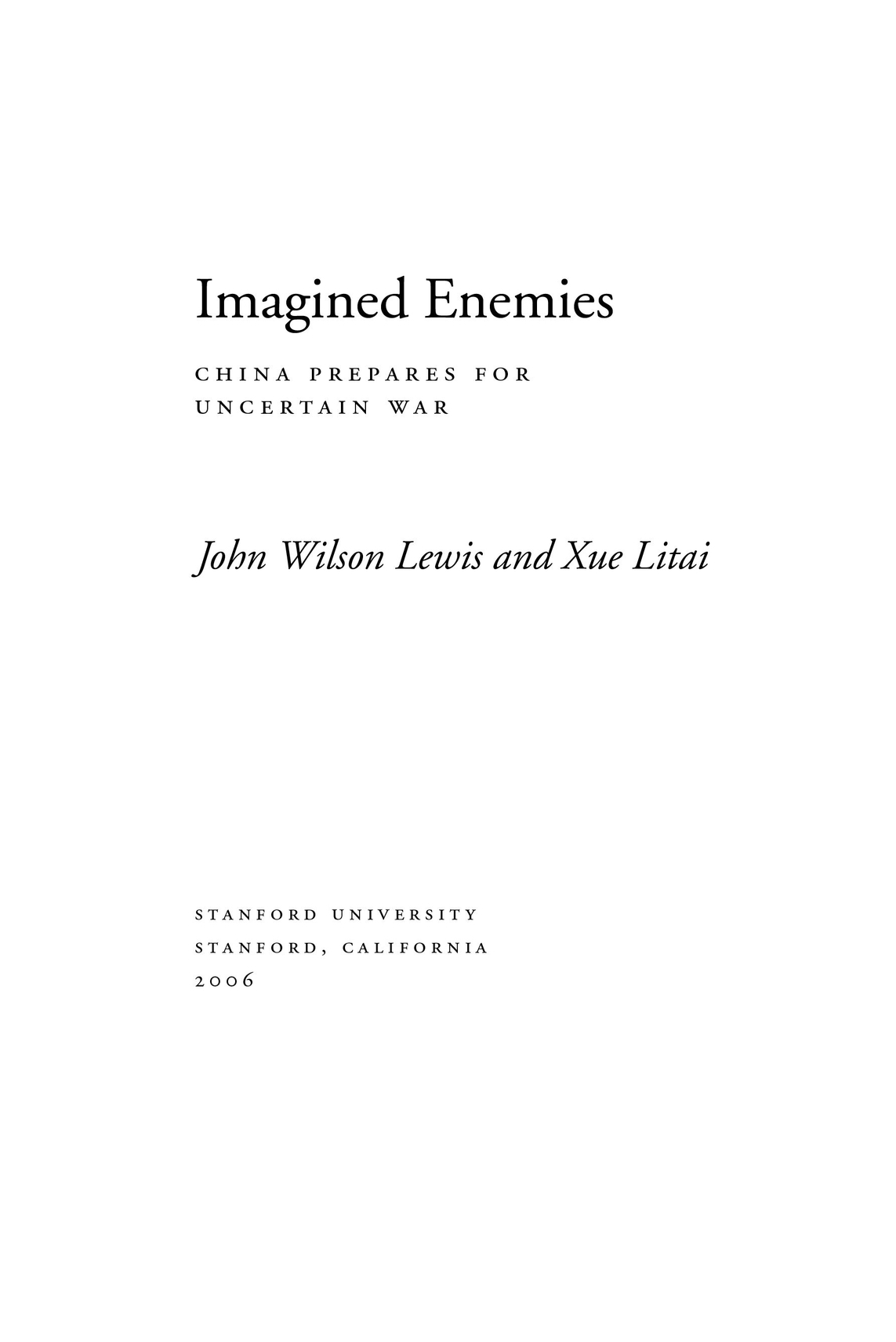Li Jijun, On Strategy, p. 23. General Li is the former vice president of the PLA Academy of Military Science.
Ba Zhongtan, Zhongguo , pp. 3, 5. General Ba was commander of the Peoples Armed Police and now is a senior adviser to the Central Military Commission.
Ibid., p. 164.
Liu Bingchen, p. 78.
Li Jijun, On Strategy, p. 23.
Wu Jiulong, p. 2. We have used the translation by General Tao Hanzhang. Most earlier histories date Sun Tzus life much later, but Taos dates are based on exhaustive research.
Quoted in Bloodworth, p. 284.
Wu Jiulong, pp. 3738.
Tao Hanzhang, p. 100.
Bloodworth, p. 285.
Tao Hanzhang, p. 104.
Guangdong, p. 784.
Ba Zhongtan, Zhongguo , p. 2.
Shi Dongbing, Xumu , p. 160.
Li Jijun, On Strategy, pp. 2224. Quoted from p. 23.
Unless otherwise cited, the information in this and the next two paragraphs is from Guo Ping, pp. 2627; Li Jijun, Junshi , pp. 6062, 175; and Li Jijun, On Strategy, pp. 2024.
See also Gong Yuzhen.
See, for example, Bao Guojun, p. 28; and Li Jijun, Junshi , p. 239.
Quoted from Li Jijun, On Strategy, p. 23.
The information in this paragraph and the next is from Ba Zhongtan, Zhongguo , p. 7; and Li Jijun, On Strategy, p. 23.
Guo Ping, pp. 2627; Li Jijun, Junshi , p. 62.
Unless otherwise cited, the information in this paragraph and the next is from Li Jijun, Junshi , p. 61.
For a description that Beijings leaders always give top priority to domestic security issues rather than international crises, see, for example, Wang Li, Vol. 2, pp. 1086, 1088.
Lin Boye et al., pp. 24042.
Peng and Yao, pp. 118, 18889. See also Shang Jinsuo et al., p. 241.
On Beijings tendency toward worst-case planning, see Yuan Zhengling, p. 23.
For further explanation of a cautious attitude toward the first battle in the CMCs war planning, see, for example, Peng and Yao, pp. 121, 25657.
Unless otherwise cited, the information in this paragraph and the next is from Li Jijun, Junshi , pp. 6062, 7475, 175, 22728; and Li Jijun, On Strategy, pp. 2024.
See Ba Zhongtan, Zhongguo , pp. 65, 66, 120, 121.
For the PLAs judgment of the need for readjusting the weapons procurement policy, see, for example, Peng and Yao, pp. 43738.
Most of the information in this paragraph and the next two is from Ba Zhongtan, Zhongguo , pp. 152, 153, 154, 161.
Interviews with Chinese air traffic control specialists and PLA Air Force officers, 199496.
Ba Zhongtan, Opening, p. 1.
Mi Zhenyu, pp. 45, 19. Lieutenant General Mi Zhenyu is vice president of the PLA Academy of Military Science.
Deng Xiaoping Talks About, p. 9; Deng Xiaoping Talks Freely, pp. 910.
Peng and Yao, pp. 462, 477.
Zhao Li, pp. 5, 6.
For a systematic analysis of this issue, see, for example, Peng and Yao, pp. 47072.
Zhou Enlai, Several, pp. 32728.
Mao Zedong, On Peoples, p. 416.
Deng Xiaoping, Speech, pp. 13233.
Deng Xiaoaping, Task, p. 34.
Deng Xiaoping, Speech, pp. 13132, 133.
Yu Zemin, p. 28.
This paragraph and the next are based on interviews with senior military officers in Beijing, April and July, 1998.
Peng and Yao, pp. 11718.
For an analysis of the background for Beijings decision to give priority to domestic issues, see Lewis and Xue, Social, pp. 2440, passim.
Cao Yingwang, p. 19.
Wang Wenrong, p. 276.
Peng and Yao, p. 238. For the background of Maos decision to prepare for an early war, an all-out war, and a nuclear war, see Lewis and Xue, Chinas Strategic Seapower , pp. 21113.
Unless otherwise cited, the information in this paragraph and the next is from Wang Wenrong, p. 276.
See, for example, Saiget; and Reduced Growth Rate.
. Sagan and Waltz.
See United States, Department of Defense, Nuclear ; the quote is from p. 16. For a Chinese assessment of the Nuclear Posture Review , see Shang Jinsuo et al., pp. 48990.
Bao Guojun, p. 28.
Wang Wenrong, p. 352. On Chinese assessments of the potential U.S. use of tactical nuclear weapons against China in a conventional conflict, see Peng and Yao, p. 477.
Bao Guojun, p. 29.
See, for example, Jiang Zhengming, pp. 1415; Xiong Yuxiang, pp. 1617; and Su Bei, p. 12.
United States, Department of Defense, Nuclear , p. 7.
The New Triad set forth in the Nuclear Posture Review would be composed of offensive strike systems, active and passive defenses, and a revitalized defense infrastructure, all bound together by enhanced command, control, and intelligence systems. United States, Department of Defense, Nuclear .
See, for example, L Qiang et al., p. 1. This paragraph is also based on interviews with strategic specialists in China in January, March, and August 2002 and February 2003. For a scholarly view of the changes in U.S. nuclear strategy by a member of the Arms Control Research Division, Institute of Applied Physics and Computational Mathematics, see Tian Jingmei.
Tian Yi, p. 9.
Sun Yamin, pp. 3738; Peng and Yao, pp. 34041. Quoted from Sun Yaomin, p. 37.
Peng and Yao, pp. 34041.
Shang Jinsuo et al., p. 348.
Tian Yi, p. 9.
Li Jiqing, p. 59.
See, for example, Wang Yusheng.
Peng and Yao, p. 122.
Unless otherwise cited, the information in this paragraph is quoted from Peng and Yao, pp. 122, 124, 126.
Shang Jinsuo et al., p. 243.
Ibid., pp. 123, 127. Quoted from p. 123.
Wang Wenrong, p. 287.
Ibid., pp. 28788.
Shang Jinsuo et al., p. 244.
Peng and Yao, p. 491.
Chen Yilin.
Wang Wenrong, pp. 28788.
Gao Shangrui.
Bao Guojun, p. 29.
Peng and Yao, pp. 45354, 49091. The quotes are from pp. 454 and 491, respectively.

